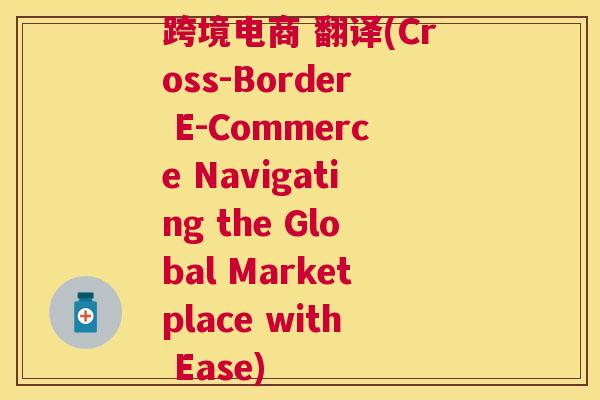Cross-Border E-Commerce: Navigating the Global Marketplace with Ease
Cross-border e-commerce refers to the buying and selling of goods and services over the internet that involves customers and businesses from different countries. It is a rapidly growing sector of the global economy, driven by advancements in technology, increased internet penetration, and the growing demand for international products. This article aims to provide an overview of cross-border e-commerce, its benefits, challenges, and strategies for businesses to navigate the global marketplace with ease.
1. Introduction to Cross-Border E-Commerce
Cross-border e-commerce has revolutionized the way businesses and consumers interact in the global marketplace. It allows businesses to expand their reach beyond their domestic markets and tap into new customer bases worldwide. For consumers, it offers access to a wider range of products and services, often at competitive prices and with greater convenience.
2. Benefits of Cross-Border E-Commerce
There are several benefits associated with cross-border e-commerce, including:

a. Expanded Market Reach: Businesses can access new markets and customer bases, leading to increased sales and revenue.
b. Cost Efficiency: Online sales channels can reduce overhead costs, such as rent and staffing, allowing businesses to offer competitive prices.
c. Increased Customer Base: By targeting international customers, businesses can diversify their customer base and reduce reliance on a single market.
d. Enhanced Brand Exposure: Cross-border e-commerce can help businesses build brand awareness and establish a global presence.
e. Improved Customer Experience: Online shopping offers convenience, speed, and a wide range of product choices, leading to increased customer satisfaction.
3. Challenges of Cross-Border E-Commerce
Despite its benefits, cross-border e-commerce also presents several challenges, such as:
a. Regulatory Compliance: Businesses must navigate complex regulations and laws in different countries, including customs, taxes, and product safety standards.
b. Currency Fluctuations: Exchange rate fluctuations can impact pricing and profitability, requiring careful financial management.
c. Logistics and Delivery: International shipping can be complex, with varying delivery times, costs, and customs clearance requirements.
d. Cultural Differences: Businesses must adapt their marketing strategies and product offerings to meet the preferences and expectations of customers in different countries.
e. Payment and Fraud Risks: Cross-border transactions can expose businesses to payment risks, such as fraud and chargebacks.
4. Strategies for Navigating Cross-Border E-Commerce
To successfully navigate the global marketplace, businesses should consider the following strategies:
a. Market Research: Conduct thorough research to understand the target market, including consumer preferences, cultural nuances, and competitive landscape.
b. Localization: Adapt product offerings, marketing materials, and website content to meet the needs and preferences of customers in different countries.
c. Partnerships: Collaborate with local partners, such as distributors and logistics providers, to navigate regulatory requirements and improve delivery efficiency.
d. Technology Adoption: Leverage technology, such as e-commerce platforms, payment gateways, and analytics tools, to streamline operations and enhance the customer experience.
e. Customer Support: Offer multilingual customer support to address inquiries and concerns from customers in different countries.
f. Risk Management: Implement robust risk management strategies, including fraud detection systems and secure payment methods, to protect against payment risks.
5. Conclusion
Cross-border e-commerce offers significant opportunities for businesses to expand their reach and tap into new markets. By understanding the benefits, challenges, and strategies for success, businesses can navigate the global marketplace with ease and build a competitive advantage in the digital age.
In conclusion, cross-border e-commerce is a dynamic and rapidly evolving sector of the global economy. It presents both opportunities and challenges for businesses looking to expand their reach and tap into new customer bases. By adopting effective strategies and leveraging technology, businesses can overcome these challenges and successfully navigate the global marketplace, ultimately driving growth and profitability.




